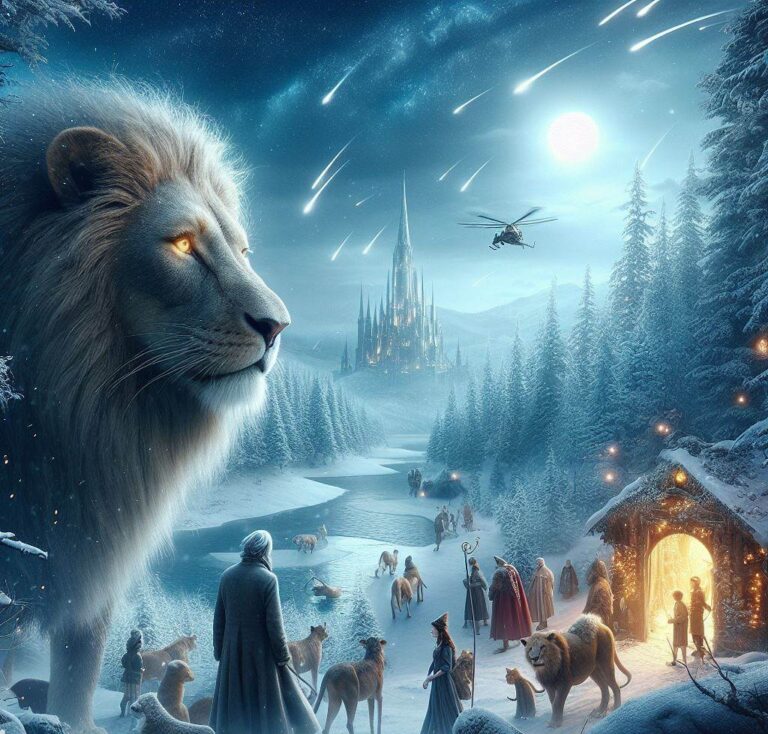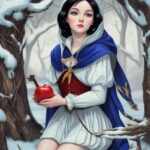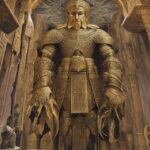Are you ready to embark on a magical journey through a world filled with enchantment and mystique? Step inside the pages of C.S. Lewis‘ timeless masterpiece, “The Lion, the Witch and the Wardrobe.” In this captivating tale, four siblings stumble upon a hidden wardrobe that transports them to the wondrous land of Narnia. But little do they know, their arrival unveils a battle between good and evil that will test their courage, loyalty, and belief in themselves. As you delve into this intricately woven narrative, prepare to be spellbound by the enchanting characters, breathtaking adventures, and profound lessons that await you.
Discover why millions of readers have been captivated by this literary gem, and join us as we unlock the secrets within the wardrobe, unraveling a tale that has stood the test of time. So, gather your curiosity, for the extraordinary lies just beyond the wardrobe’s doors…
The Lion, the Witch and the Wardrobe: Full Book Summary
Once upon a time, in a small and simple house, lived four children named Peter, Susan, Edmund, and Lucy. Every year, they would visit their grandfather in the countryside during the summer vacation. However, this year was different. Due to a terrible war, the children had to stay with an old professor in a mysterious house instead.
The professor’s house was enormous and filled with strange artifacts from different parts of the world. In one room, there was a massive old wardrobe, which caught the attention of the curious Lucy. One rainy day, as the children played hide and seek, Lucy decided to hide inside the wardrobe to escape her brothers and sister. However, the minute she climbed into the wardrobe, she found herself in a different world—a snowy forest called Narnia.
As Lucy explored Narnia, she met a faun named Mr. Tumnus. He had a kind face, but Lucy noticed he looked sad. Mr. Tumnus explained that Narnia was under the rule of a wicked witch called the White Witch, who had turned the land into an eternal winter. The curious little girl and the friendly faun spent hours talking and having tea until Lucy realized she had to return to her world.
Excitedly, Lucy shared her extraordinary experience with her siblings. However, they thought she was just making up stories. Especially Edmund, the youngest but most troublesome of them all. He was always teasing and mocking his siblings, and the idea of a magical world seemed ridiculous to him.
Determined to prove her adventure was real, Lucy decided to take her siblings to Narnia. She led them to the wardrobe one evening, urging them to step inside. Peter, the eldest, hesitated but eventually entered along with Susan. However, Edmund remained skeptical and chose to hide instead, secretly hoping to catch his siblings when they returned disappointed.
To his surprise, Edmund soon found himself in Narnia as well. He met the White Witch, who cleverly tricked him into believing that she was the rightful ruler of Narnia. She offered him enchanted Turkish Delight, his favorite treat, in exchange for information about his siblings. Bit by bit, Edmund’s selfishness and greed allowed the witch to manipulate him.
Meanwhile, in Narnia, Peter, Susan, and Lucy discovered a group of creatures who had been turned into statues under the witch’s spell. A majestic lion named Aslan, the true king of Narnia, appeared to them in a magnificent clearing. Aslan promised to help the children rescue Edmund from the clutches of the White Witch.
The siblings, guided by Aslan, gathered a group of loyal animals and creatures of Narnia their journey to rescue Edmund and free Narnia from the wicked witch’s icy grip. Along the way, they faced many challenges and overcame various obstacles, leaving them stronger and more determined than ever.
As the final battle between good and evil approached, Edmund, burdened with guilt, confessed his betrayal to his siblings. They forgave him, and together with Aslan, they prepared for the ultimate showdown with the White Witch.
The battle was fierce but, with Aslan’s help, the children emerged victorious. The White Witch’s hold on Narnia was broken, and spring finally returned to the land. Aslan crowned the children as Kings and Queens of Narnia, and they ruled with wisdom and grace, ensuring peace and prosperity for all life in the magical realm.
However, their time in Narnia was not meant to last forever. Several years passed, and one day, as the children were enjoying a chase on the outskirts of the professor’s home, they stumbled upon the magical wardrobe once more. To their astonishment, they found themselves back in the spare room where their adventure had begun.
They all agreed to keep their incredible journey a secret, for they knew no one, not even their parents, would believe their extraordinary tale. But the bond they formed in Narnia remained unbreakable, and the lessons they learned about courage, forgiveness, and selflessness would stay with them forever.
And so, the four children grew older, but the enchantment of Narnia lingered in their hearts. They would often smile and exchange knowing glances whenever they stumbled upon a wardrobe, remembering the magical world that changed their lives forever.
The Lion, the Witch and the Wardrobe: Key Themes
“The Lion, the Witch and the Wardrobe” is a classic fantasy novel written by C.S. Lewis. The story revolves around four siblings, Peter, Susan, Edmund, and Lucy, who discover a magical wardrobe that leads them into a mystical land called Narnia. In this magical world, they encounter talking animals, mythical creatures, and a battle between good and evil. The book explores several themes that resonate with readers of all ages.
1. The Power of Sacrifice and Redemption: One of the central themes of “The Lion, the Witch and the Wardrobe” revolves around sacrifice and redemption. Edmund, one of the main characters, betrays his siblings and aligns himself with the White Witch. However, through the sacrificial death and subsequent resurrection of Aslan, the lion and the true king of Narnia, Edmund is redeemed and given a chance to make amends for his past mistakes. This theme emphasizes the importance of forgiveness, redemption, and selflessness.
2. Good vs. Evil: The conflict between good and evil is a prominent theme in this book. The White Witch represents evil as she tyrannically holds Narnia under her winter spell, spreading fear and repression. Aslan symbolizes goodness and serves as a Christ-like figure who sacrifices himself for the salvation and liberation of Narnia. The story explores how good can triumph over evil, even in the face of overwhelming odds, through bravery, loyalty, and the power of sacrificial love.
3. The Journey of Faith and Belief: Another significant theme is the journey of faith and belief. The Pevensie children, particularly Lucy, initially encounter skepticism and doubt from their siblings when they share their experiences in Narnia. However, as the story progresses and they witness the magic and wonder of this parallel world, they learn to believe and have faith in their own experiences and in the existence of the magical land. The theme emphasizes the importance of belief and the transformative power it can have on individuals.
Overall, “The Lion, the Witch and the Wardrobe” delves into themes of sacrifice, redemption, good vs. evil, and the journey of faith and belief. Through its enchanting storytelling, the book leaves readers with valuable life lessons and insights into the human condition.
The Lion, the Witch and the Wardrobe: Characters
– Lucy Pevensie: The youngest of the Pevensie siblings, Lucy is a delightfully curious and imaginative little girl. With her bright blue eyes and a head full of wild, golden curls, she possesses a childlike innocence that endears her to everyone she meets. Lucy stumbles upon the magical world of Narnia through a mysterious wardrobe, and her unwavering bravery and unwavering belief in the good of others become the guiding light for her siblings.
– Peter Pevensie: The eldest Pevensie sibling, Peter is a natural-born leader with an impressive height and broad shoulders that command attention. With his dark, tousled hair and thoughtful eyes, he exudes a sense of responsibility. Throughout the story, Peter transforms from a protective big brother to a valiant warrior, leading Narnia’s forces against the tyrannical rule of the White Witch.
– Susan Pevensie: Susan, the second eldest Pevensie sibling, possesses a grace and elegance that matches her nurturing nature. Her hazel eyes twinkle with intelligence, and her chestnut hair flows in waves down her back. Susan is often the voice of reason within the group, questioning ideas with a logical mind. She displays great archery skills, becoming a formidable warrior in Narnia.
– Edmund Pevensie: Oh, Edmund, the little mischief-maker! With his mischievous hazel eyes and freckles sprinkled across his nose, he appears to be a misfit among the Pevensie siblings. While initially swayed by the White Witch’s temptations, Edmund’s journey takes a pivotal turn as he learns the power of redemption and forgiveness. His transformation from the boy who betrayed his siblings to a hero is remarkable and inspiring.
– Aslan: The majestic and noble lion who reigns over Narnia, Aslan is a breathtaking sight to behold. With his golden mane and deep, wise eyes, he symbolizes strength, courage, and goodness. Aslan is the true heart of the story, embodying self-sacrifice and compassion. His presence inspires hope and awe, drawing every character and reader into his magnetic aura.
– The White Witch: The icy enchantress of Narnia, the White Witch, strikes both fear and awe in the hearts of those who encounter her. With her pale skin and piercing ice-blue eyes, she exudes an otherworldly allure. Her cruel and cunning nature is matched only by her desire for power and control. The White Witch embodies the captivating and intimidating depths of darkness.
– Mr. Tumnus: A charming and lovable creature, Mr. Tumnus is a faun with a love for music, tea, and all things whimsical. With his warm, goat-like features, including spiral horns and cloven hooves, Mr. Tumnus has a gentle nature that instantly puts others at ease. Despite working as a spy for the White Witch, his loyalty shines through as he befriends Lucy and becomes one of Narnia’s most endearing characters.
The Lion, the Witch and the Wardrobe: Symbols
1. Wardrobe: The wardrobe is a significant symbol in the book as it serves as a portal to the magical world of Narnia. It symbolizes the power of imagination and the ability to escape from the mundane reality into a world of adventure and wonder. The wardrobe represents the possibility of discovering a hidden, enchanting realm beyond what is visible to the naked eye.
2. Aslan: Aslan, the majestic lion, is one of the central symbols in the book. He represents wisdom, courage, and self-sacrifice. Aslan symbolizes Jesus Christ in Christian allegory, as he is a divine figure who sacrifices himself to save others. Aslan’s noble character and powerful presence bring hope, strength, and guidance to the main characters, highlighting the triumph of good over evil.
3. The White Witch’s Wand: The White Witch’s wand symbolizes her tyrannical power and her desire for control. It is a representation of dark magic and evil authority. The wand serves as a reminder of the Witch’s rule over Narnia and the fear she instills in its inhabitants. The wand also represents the corrupting influence of power, as the Witch uses it to manipulate and oppress others.
The Lion, the Witch and the Wardrobe: Culture Impact
Published in 1950, “The Lion, the Witch, and the Wardrobe” is a beloved fantasy novel written by C.S. Lewis. It is part of the iconic “Chronicles of Narnia” series, which has captivated generations of readers. This book, in particular, has left an indelible impact on popular culture, history, and literary achievements, making it a timeless classic in the world of literature.
Historic and Cultural Significance:
“The Lion, the Witch, and the Wardrobe” has played a crucial role in the cultural landscape, with its impact resonating far beyond its original publication. Here are some key cultural impacts of this extraordinary book:
1. Introducing Children to the Rich World of Fantasy:
One of the greatest achievements of this book lies in its ability to introduce children to the enchanting realm of fantasy. Its gripping storyline, vivid imagery, and magical characters have enthralled young readers for generations.
2. Allegory and Symbolism of Morality:
An allegorical tale, “The Lion, the Witch, and the Wardrobe” incorporates powerful symbolism that mirrors Christian themes and moral lessons. This unique blend of fantastical storytelling and profound messages has made it a favorite among readers seeking deeper meanings.
3. Influence on the Fantasy Genre:
As a pioneering work in the fantasy genre, this book has served as a major source of influence for subsequent novels and series. Its imaginative world-building, talking animals, and epic battles between good and evil have inspired numerous authors and filmmakers.
Funny Anecdotes and Cultural Memes:
“The Lion, the Witch, and the Wardrobe” has also generated a myriad of funny anecdotes and cultural memes that continue to delight readers and fans. Some memorable moments include:
1. Turkish Delight Obsession:
The book’s villainous White Witch uses Turkish Delight to tempt Edmund, one of the main characters. This has since become a running joke, with many fans playfully referencing Turkish Delight as a source of temptation or indulgence.
2. Wardrobe as a Hidden Gateway:
The image of a seemingly ordinary wardrobe concealing a magical portal to Narnia has become an enduring symbol. It has inspired countless jokes about exploring hidden worlds through unlikely entry points, such as wardrobes, closets, and even backyard sheds.
Achievements and Accolades:
“The Lion, the Witch, and the Wardrobe” has garnered widespread recognition and acclaim. Some of its notable achievements include:
1. Member of the Beloved “Chronicles of Narnia” Series:
The book’s enduring popularity has made it a cornerstone of the “Chronicles of Narnia” series. Each subsequent installment builds upon the fantastical world initially established in this highly influential book.
2. International Bestseller:
Since its publication, the book has sold millions of copies worldwide and has been translated into numerous languages. This global success is a testament to the universal appeal and cultural impact of its narrative.
3. Successful Film Adaptation:
In 2005, “The Lion, the Witch, and the Wardrobe” was adapted into a critically acclaimed film. This adaptation not only brought the magical story to life but also introduced a new generation to the enchanting world of Narnia.
Conclusion:
“The Lion, the Witch, and the Wardrobe” has left an unmistakable cultural impact that encompasses literature, film, and popular imagination. Through its unforgettable characters, allegorical themes, and timeless storytelling, this book continues to inspire and captivate readers of all ages. It remains a cherished treasure in the realm of literature, forever weaving its magic into the tapestry of our culture.
FAQs
1. Who are the main characters in The Lion, the Witch and the Wardrobe?
The main characters in The Lion, the Witch and the Wardrobe are the four Pevensie siblings – Peter, Susan, Edmund, and Lucy. Additionally, there are various other memorable characters such as the White Witch and Aslan.
2. Q: What is the story of the Lion, The Witch and the Wardrobe about?
The Lion, the Witch and the Wardrobe is a fantasy novel that follows the adventures of the Pevensie children as they stumble upon a magical wardrobe that transports them to the enchanting land of Narnia. There, they become embroiled in a battle between good and evil, with the White Witch ruling over Narnia and Aslan, the lion, representing the forces of good.
3. Is The Lion, the Witch and the Wardrobe part of a series?
Yes, The Lion, the Witch and the Wardrobe is the first book in C.S. Lewis’ series known as “The Chronicles of Narnia.” There are a total of seven books in the series, each exploring different events and characters within the world of Narnia.
4. Is The Lion, the Witch and the Wardrobe suitable for children?
Yes, The Lion, the Witch and the Wardrobe is widely considered a children’s book, suitable for readers of all ages. It is a classic work of children’s literature and has been enjoyed by generations.
5. Is the book the same as the movie adaptation?
While the storyline remains largely faithful to the book, there are often adaptations and changes made when a book is turned into a movie. Some differences may be present in the movie adaptation of The Lion, the Witch and the Wardrobe, but it still captures the essence of the original story.
6. What is the setting and time period of the book?
The book is set in two different worlds: the real world of England during World War II, and the fantasy world of Narnia, a land of talking animals, mythical creatures, and magic. The book begins in 1940, when four siblings, Peter, Susan, Edmund, and Lucy Pevensie, are sent to live with an old professor in the countryside to escape the bombings of London. There, they discover a wardrobe that leads them to Narnia, where they have various adventures and encounter the evil White Witch, who has cast a spell of eternal winter over the land. They also meet Aslan, the great lion and the true king of Narnia, who sacrifices himself to save Edmund from the Witch’s power, and then resurrects to lead the final battle against her and her army.
7. Who are the main characters and what are their roles in the story?
The main characters are the four Pevensie children, who are the protagonists and the heroes of the story. They are also the fulfillment of an ancient prophecy that says that four human children will come to Narnia and help Aslan defeat the White Witch and restore peace and spring to the land. Each of them has a different personality and a different role in the story. Peter is the oldest and the most responsible, and he becomes the High King of Narnia after the victory. Susan is the second oldest and the most sensible, and she becomes the Gentle Queen of Narnia. Edmund is the third oldest and the most rebellious, and he betrays his siblings and joins the White Witch, but later repents and becomes the Just King of Narnia. Lucy is the youngest and the most innocent, and she is the first to enter Narnia and befriend Mr. Tumnus, the faun. She also becomes the Valiant Queen of Narnia.
8. What are the main themes and messages of the book?
The book explores several themes and messages, such as the power of faith, the nature of good and evil, the consequences of choices, the value of friendship, and the meaning of sacrifice. One of the most prominent themes is the Christian allegory, as the book parallels the story of Jesus Christ and his death and resurrection. Aslan represents Christ, who willingly dies to save Edmund, who represents the sinner, from the White Witch, who represents Satan. Aslan also rises from the dead on the third day, and defeats the Witch and her forces, who represent the powers of darkness. The book also shows the importance of believing in Aslan, even when he seems absent or mysterious, as Lucy and Susan do, and the danger of doubting or denying him, as Edmund and the professor’s housekeeper do.
9. How did C.S. Lewis come up with the idea for the book and the series?
C.S. Lewis was inspired by various sources and influences to write the book and the series. He was a fan of fantasy and mythology since his childhood, and he also had a vivid imagination and a love for storytelling. He said that the image of a faun carrying an umbrella and parcels in a snowy wood came to his mind when he was 16, and that it stayed with him for years. He also said that the lion Aslan came “bounding” into his story, and that he did not know how or why. He also drew from his own experiences of living through World War II, and his conversion to Christianity, which shaped his worldview and his writing. He also incorporated elements from various literary works, such as the works of George MacDonald, J.R.R. Tolkien, Edmund Spenser, and Greek and Norse mythology .
10. What is the significance of the title and the order of the book and the series?
The title of the book refers to the three main characters and symbols of the story: the lion Aslan, the witch Jadis, and the wardrobe that serves as the portal to Narnia. The book is the first one that C.S. Lewis wrote and published in the series, and it is also the most popular and well-known one. However, it is not the first one in the chronological order of the series, as it is preceded by The Magician’s Nephew, which tells the story of the creation of Narnia and the origin of the Witch and the wardrobe. The order of the series has been a subject of debate and controversy among fans and publishers, as some prefer the original publication order, while others prefer the chronological order. C.S. Lewis himself did not have a strong preference, and he said that the order of reading does not matter much, as long as the reader enjoys the stories .










